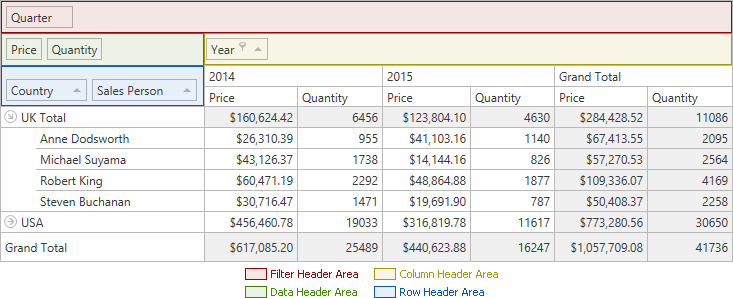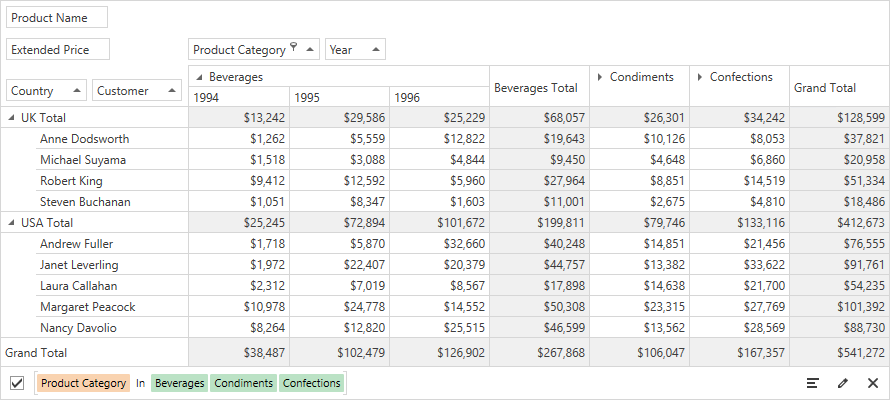Fields
- 7 minutes to read
Pivot Grid Fields supply data to the Pivot Grid control. Fields are visualized with field headers. You can drag-and-drop fields between Pivot Grid areas to modify the Pivot Grid layout.
Create and Position Pivot Grid Fields
To visualize data in the Pivot Grid, create Pivot Grid fields and position them within one of the following areas: Data, Row, Column, or Filter Header Area.
Follow the steps below to create and position fields in code:
- Create a PivotGridField object and add it to the PivotGridControl.Fields collection.
- Specify the field’s area and position within this area. To do this, use the PivotGridField.Area and PivotGridField.AreaIndex.
AreaIndexcan be set only after the field is added to the control’s field collection.

The field’s function is determined by the area in which it is displayed:
- Column Header Area
- Lists field values along the control’s top edge. Field values are column headers.
- Row Header Area
- Lists field values along the control’s left edge. Field values are row headers.
- Data Header Area
- Calculates summaries against the fields in column and row areas. The summaries are calculated for all cells, and each cell is identified by a column and a row.
- Filter Header Area
- Displays headers of filter fields. Filter fields allow users to filter the entire Pivot Grid to display data for the predefined values from the filter dropdown list.
Bind Pivot Grid Fields to Data
Pivot Grid uses the Binding API to bind Pivot Grid fields to data. Data binding sources can be columns in a data source, calculated expressions, or window calculations.
Refer to the following help topics for more information on how to bind Pivot Grid fields to different data binding sources:
- Bind Pivot Grid Fields to Data Columns
- Bind Pivot Grid Fields to Calculated Expressions
- Bind Pivot Grid Fields to Window Calculations
Example
The following example demonstrates how to bind the PivotGridControl to a “SalesPerson” view in the nwind.mdb database, which ships with the installation.
Follow the steps below to connect the Pivot Grid to a database.
- Create an OleDbConnection object and specify the connection string in its constructor.
- Create an
OleDbDataAdapterinstance to select records from the data source. - Create a new
DataSetobject and populate it with data. - Use the PivotGridControl.DataSource property to assign the resulting data source to the Pivot Grid.
Follow the steps below to create and configure Pivot Grid fields.
- Create a PivotGridField object and add it to the PivotGridControl.Fields collection.
- Specify the field’s area and position within this area. For this, use the PivotGridFieldBase.Area and PivotGridField.AreaIndex properties.
AreaIndexcan be set only after the field is added to the control’s field collection. - Create a DataSourceColumnBinding object for each field.
- Set the DataSourceColumnBinding.ColumnName property to the name of the column in the data source. The Pivot Grid fields obtain their values from columns in the data source.
- Assign the
DataSourceColumnBindingobject to the field’s PivotGridField.DataBinding property.
Note that if you want to see an example of how to add pivot grid fields in XAML, please refer to the following tutorial: How to: Bind a PivotGrid to an MS Access Database.
using System.Data;
using System.Data.OleDb;
using System.Windows;
using DevExpress.Xpf.PivotGrid;
namespace HowToBindToMDB {
public partial class MainWindow : Window {
public MainWindow() {
InitializeComponent();
}
private void Window_Loaded(object sender, RoutedEventArgs e) {
// Create a connection object.
OleDbConnection connection =
new OleDbConnection("Provider=Microsoft.Jet.OLEDB.4.0;Data Source=NWIND.MDB");
// Create a data adapter.
OleDbDataAdapter adapter =
new OleDbDataAdapter("SELECT * FROM SalesPerson", connection);
// Create and fill a dataset.
DataSet sourceDataSet = new DataSet();
adapter.Fill(sourceDataSet, "SalesPerson");
// Assign the data source to the PivotGrid control.
pivotGridControl1.DataSource = sourceDataSet.Tables["SalesPerson"];
pivotGridControl1.DataProcessingEngine = DataProcessingEngine.Optimized;
pivotGridControl1.BeginUpdate();
// Create a row pivot grid field bound to the Country data source column.
PivotGridField fieldCountry = new PivotGridField();
fieldCountry.Caption = "Country";
fieldCountry.Area = FieldArea.RowArea;
DataSourceColumnBinding countryBinding = new DataSourceColumnBinding("Country");
fieldCountry.DataBinding = countryBinding;
// Create a row pivot grid field bound to the Sales Person data source column.
PivotGridField fieldCustomer = new PivotGridField();
fieldCustomer.Caption = "Customer";
fieldCustomer.Area = FieldArea.RowArea;
DataSourceColumnBinding customerBinding = new DataSourceColumnBinding("Sales Person");
fieldCustomer.DataBinding = customerBinding;
// Create a column pivot grid field bound to the OrderDate data source column.
PivotGridField fieldYear = new PivotGridField();
fieldYear.Caption = "Year";
fieldYear.Area = FieldArea.ColumnArea;
DataSourceColumnBinding fieldOrderDate1Binding = new DataSourceColumnBinding("OrderDate");
fieldOrderDate1Binding.GroupInterval = FieldGroupInterval.DateYear;
fieldYear.DataBinding = fieldOrderDate1Binding;
// Create a column pivot grid field bound to the CategoryName data source column.
PivotGridField fieldCategoryName = new PivotGridField();
fieldCategoryName.Caption = "Product Category";
fieldCategoryName.Area = FieldArea.ColumnArea;
DataSourceColumnBinding categoryNameBinding = new DataSourceColumnBinding("CategoryName");
fieldCategoryName.DataBinding = categoryNameBinding;
// Create a filter pivot grid field bound to the ProductName data source column.
PivotGridField fieldProductName = new PivotGridField();
fieldProductName.Caption = "Product Name";
fieldProductName.Area = FieldArea.FilterArea;
DataSourceColumnBinding productNameBinding = new DataSourceColumnBinding("ProductName");
fieldProductName.DataBinding = productNameBinding;
// Create a data pivot grid field bound to the 'Extended Price' data source column.
PivotGridField fieldExtendedPrice = new PivotGridField();
fieldExtendedPrice.Area = FieldArea.DataArea;
DataSourceColumnBinding extendedPriceBinding = new DataSourceColumnBinding("Extended Price");
fieldExtendedPrice.DataBinding = extendedPriceBinding;
// Specify the formatting setting to format summary values as integer currency amount.
fieldExtendedPrice.CellFormat = "c0";
// Add the fields to the control's field collection.
pivotGridControl1.Fields.AddRange(fieldCountry, fieldCustomer,
fieldCategoryName, fieldProductName, fieldYear, fieldExtendedPrice);
// Arrange the row fields within the Row Header Area.
fieldCountry.AreaIndex = 0;
fieldCustomer.AreaIndex = 1;
// Arrange the column fields within the Column Header Area.
fieldCategoryName.AreaIndex = 0;
fieldYear.AreaIndex = 1;
pivotGridControl1.EndUpdate();
}
}
}
Run the project and see the result:
